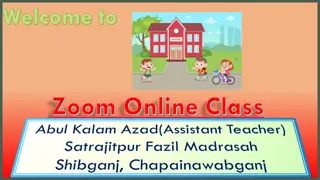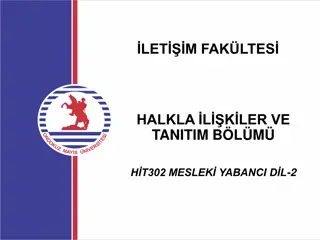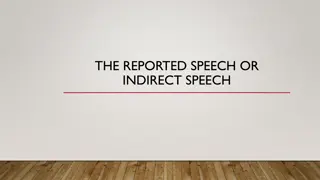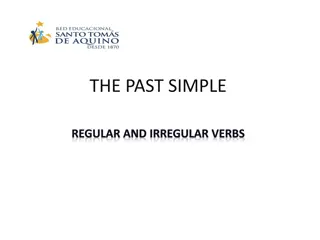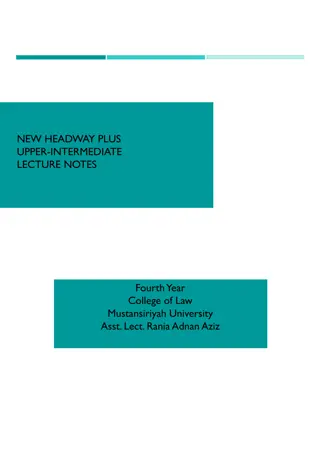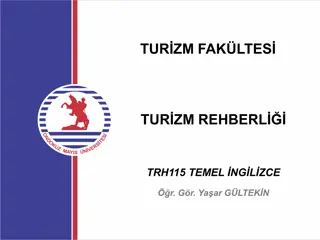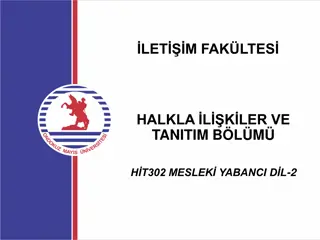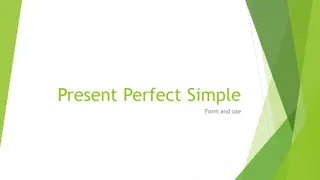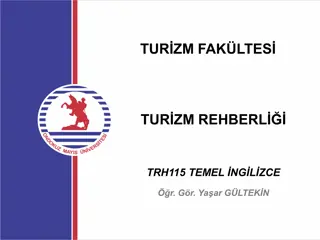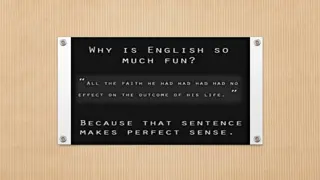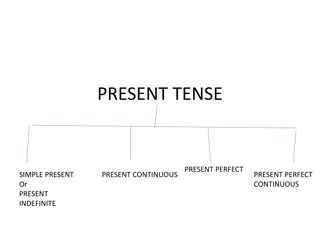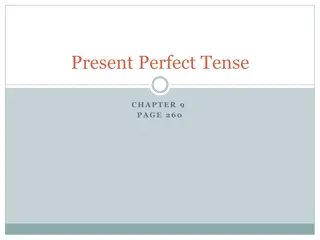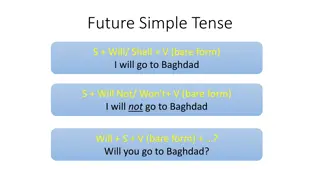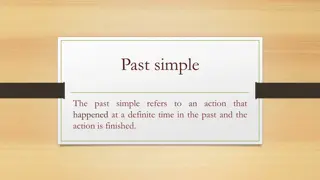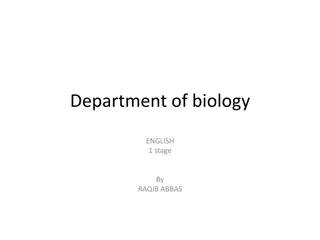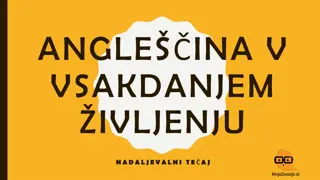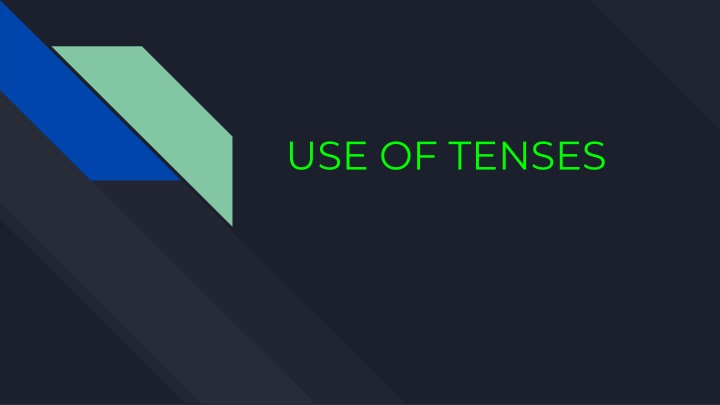
English Tenses: Categories, Forms, and Usage
Learn about the different categories of persons, types of sentences, and forms of present tense in English grammar. Explore how to structure affirmative, negative, and interrogative sentences in the present simple tense, along with the adverbs commonly used in this tense. Discover immediate reactions and communication scenarios where the present simple tense is applied.
Download Presentation

Please find below an Image/Link to download the presentation.
The content on the website is provided AS IS for your information and personal use only. It may not be sold, licensed, or shared on other websites without obtaining consent from the author. If you encounter any issues during the download, it is possible that the publisher has removed the file from their server.
You are allowed to download the files provided on this website for personal or commercial use, subject to the condition that they are used lawfully. All files are the property of their respective owners.
The content on the website is provided AS IS for your information and personal use only. It may not be sold, licensed, or shared on other websites without obtaining consent from the author.
E N D
Presentation Transcript
Categories of persons I I, WE II YOU III HE ,SHE ,IT, THEY and ANY NAME
TYPES OF SENTENCES AFFIRMATIVE or POSITIVE NEGATIVE INTERROGATIVE INTERROGATIVE NEGATIVE
PRESENT TENSE FORMS: I INDEFINITE II CONTINUOUS III PERFECT IV PERFECT CONTINUOUS
PRESENT TENSE Present time is seen either as the moment of speaking or writing, or as time around now , or as the more general, permanent time relating to truths and general facts.
PRESENT SIMPLE STRUCTURES: AFFIRMATIVE SENTENCE: SUBJECT+MAIN VERB+OBJECT .\ I, you, we, they and plural subjects take the first form of the main verb He, she, it, and singular subject take s/es with main verb
Negative Sentence Subject+ do/does+main I form+ object . HE,SHE, IT, SINGULAR SUBJECT - DOES I, YOU, WE, THEY, PLURAL SUBJECT - DO
INTERROGATIVE SENTENCE DO/DOES+SUBJECT+MAIN VERB+OBJECT INTERROGATIVE NEGATIVE DO/DOES+SUBJECT+NOT+MAIN VERB+ OBJECT
ADVERBS USED IN PRESENT SIMPLE EVERYDAY, DAILY, OFTEN , ALWAYS, REGULARLY, PUNCTUALLY, RARELY, SOMETIMES, NEVER General truths and facts Regular and habitual events
Immediate reactions The present simple can be used to talk about feelings and reactions experienced at the moment of speaking: It tastes very bitter. Are you sure it s chocolate? It can also be used to describe immediate perceptions and feelings: Quick! Open the car window! I feel sick!
Immediate communication The present simple is used in commentaries on sports events and on public ceremonies. Commentators use the form to describe what they can see immediately before them, especially if it forms a sequence of actions which are completed as the commentator speaks: [football match commentary] ... Gillespie beats his man on the outside and moves forward. A similar use occurs in demonstrations and in instructions: [a plumber is showing a friend how to mend a tap which is leaking] You put the washer on first, then the metal ring and then you tighten the screw.
Mental process verbs Verbs such as hear, know, reckon, see, suppose, think, understand, are most typically used in the present simple, not the progressive: I hear you went to see the rugby match.
PRESENT CONTINUOUS HELPING VERBS IS - HE, SHE , IT and SINGULAR SUBJECT ARE- YOU, WE, THEY and PLURAL SUBJECTS AM- I MAIN VERB- VERB+ ING
SENTENCE STRUCTURE AFFIRMATIVE- SUB+ HELPING VERB+ MAIN VERB+ ING+ OBJECT . EXAMPLE- They are playing cricket now. NEGATIVE- SUB+H.V.+NOT+M.V.+ING+OBJECT . They are not playing cricket now.
INTERROGATIVE- H.V. + SUBJECT+M.V. +OBJECT . Are they playing cricket? INTERROGATIVE NEGATIVE H.V. +SUBJECT+NOT+M.V. +OBJECT Are they not playing cricket now? Adverbs of present continuous NOW, AT THIS TIME, NOWADAYS,PRESENTLY,STILL
USES OF PRESENT CONTINUOUS Events in progress at the time of speaking The present progressive is used to refer to events which are in progress or happening at the moment of speaking EXAMPLE [someone on the telephone whilst being given directions] I m looking across the road now and all I can see is a chemist s shop.
Repeated events in temporary contexts The present progressive is also used to describe actions which are repeated or regular, but are either temporary or may be judged to be temporary: EXAMPLE She s seeing him quite a bit at the moment. (she s meeting him regularly) Is she still swimming three times a week? (implies she has recently started swimming three times a week; compare: Does she still swim three times a week? , which implies she has always swum three times a week) Processes of change The present progressive is used to refer to gradual processes of change: He s been in hospital for three weeks but is improving steadily. They re building a new by-pass. It ll be good for the town but it s taking ages to finish.
With adverbs of indefinite frequency The present progressive is often used with indefinite frequency adverbs such as always, constantly, continually and forever to describe events which are regular but not planned, and often undesired: I m always losing my car keys. I really must get one of those massive big key rings. I m constantly telling the children not to go in there. S h e s forever doing homework.
Verbs rarely used in the present progressive Some verbs in English are only rarely used in the present progressive. These include: verbs which describe mental states and processes such as believe, know, think, understand ( verbs which describe responses of the senses such as smell, taste verbs expressing emotional responses such as admire, adore, detest, hate, like, respect verbs which describe an ongoing process such as have to, need, want speech act verbs such as appreciate, deny, promise, swear verbs describing permanent qualities or characteristics such as consist, contain, hold, last, take
However, when used to describe a current process at the moment of speaking, or to give extra emphasis to the ongoing nature of the event, these verbs may occur in the present progressive: What are you thinking? (What thoughts are passing through your mind at this moment?; compare What do you think? , which usually means What is your opinion? ) I m understanding things better now, since I started going to the lectures. (emphasises understanding as a developing process; compare I understand , which treats understanding as an achieved state) [whilst preparing and tasting food] I m tasting something very bitter on my tongue at the moment. (there is a kind of tentativeness here; compare it tastes bitter
The verb be in the present progressive When the copular verb be is used in the present progressive with an adjectival complement, it refers to the current actions or behaviour of the subject rather than referring to a quality or attribute of the subject: I think she is being awfully broad minded and tolerant here. (she is acting in a broad minded and tolerant way; compare I think she is broadminded , which would be an expression of a general opinion about her character) Stop it! You're being silly. ( You re silly would suggest a more general evaluation of the person s character)
INDIRECTNESS AND POLITENESS The present progressive is often used to make a request, enquiry or statement of opinion more indirect, often out of politeness: [a muffin is a kind of cake] Are you wanting a muffin, Peter? (less direct than Do you want...? ) I m wondering when I could come and pick up the calendars that I ordered from you at the beginning of October. (less direct than I wonder when I could ... ) We re hoping that it will have some practical benefits. (less direct than We hope that i t ... )
PRESENT SIMPLE AND CONTINUOUS: COMPARISON The present simple sees time in terms of facts, truths, generalities and permanent states of affairs. The present progressive sees time more in terms of its unfolding at the moment of speaking, and observes actions and events from within, as ongoing, in progress: I love Udaipur. This is a wonderful plant. It flowers all summer. It s raining now. We re making progress.
Sometimes the differences may not be great, and may only suggest more of a sense or possibility of permanence in the case of the simple form and a sense or possibility of being only temporary in the progressive: We live in a small village. I feel more confident these days. (focus is on facts, suggesting the possibility of greater permanence) We re living in a small village. I m feeling more confident these days. (focus is on present situation, with less focus on permanence)
PRESENT TIME REFERENCES WITH THE PAST TENSE for reasons of indirectness and politeness, the past simple and the past progressive may sometimes be used with present-time reference, especially with verbs such as be, hope, look for, think, want, wonder. [on the phone to train timetable enquiries] Actually I wanted to check if there s a twenty-five- past train. [at a cosmetics counter in a store, enquiring about face protection products; A is the customer] A: What s the best kind? B: Probably just a very light liquid. A: Right. I was looking for one for the cold weather, you know. [customer in a travel agent s] We were wondering about going to Amsterdam. We were wanting to stay in tents or in a caravan or in a bed and breakfast, to sort o f see what the different prices were. [dry cleaner s store: customer (B) is leaving a jacket for cleaning] A: Right. What was the name please? B: Smith. 9B e is not used in the past tense form in this way to comment on the immediate situation: [dinner guest to host, at the moment of tasting a fish dish] A: Mm. This fish is delicious. B: Thank you. I m glad you like it. (This fish was delicious.)
Note also the expression Its time .... When used with a finite clause, the verb is in the past simple form: It s time you got up. (It s time-you get up.) It s time that we did something about it WILL REFERRING TO GENERAL TRUTHS OR USED FOR POLITENESS Will can be used to refer to generally accepted truths and to what we might always expect to happen: I suppose most people zvill prefer to own their home. In the evening he ll sit all night watching TV. Will can sometimes be used to soften a directive or to make it more polite: I m sorry but have to ask you to sit in the Waiting Room for a few minutes. (compare the more direct: I m sorry but I have to ask you to sit in the Waiting Room...) Will you turn the TV down please. I m on the phone. also Will
THE SUBJUNCTIVE In formal and literary styles, present references to unfulfilled actions or events may be in the subjunctive mood after verbs such as demand, insist, recommend, require, stipulate. The subjunctive mood uses the base form of the verb for all persons (i.e. no final -s on third person singular; ): The Head of Security has demanded that the guard resign. I insist that she do these things herself. It is recommended that they repay the amount stolen in full within one year.
Present Perfect Tense Helping Verbs: HAS , HAVE HAS: HE, SHE, IT, SINGULAR SUBJECT HAVE: I, YOU, WE, THEY, PLURAL SUBJECT MAIN VERB: III FORM (PERFECT FORM) STRUCTURE: SUBJECT+ HAS/HAVE+ VERB III FORM+ OBJECTS .
USES OF PRESENT PERFECT FOR RECENTLY COMPLETED ACTIONS The train has just left the platform. FOR THE ACTIONS WHICH BEGAN IN THE PAST AND CONTINUED THROUGHOUT AN INCOMPLETE PERIOd I have seen tigers in that forest. ...It implies that it is still possible to see tigers there. RECENT ACTIONS IN THE PRESENT PERFECT OFTEN HAVE RESULTS IN THE PRESENT I have washed the car.
Adverbs used in present perfect tense Just, recently, lately, occasionally, already etc.
Present Perfect Continuous Tense Helping Verbs: HAS ,HAVE + BEEN MAIN VERB: v+ ING USE OF SINCE AND FOR SINCE: POINT OF TIME EXAMPLE: DEFINITE TIME, DATE , YEAR , MONTH SINCE SIX O CLOCK FOR: PERIOD OF TIME EXAMPLE: FOR SIX DAYS, FOR A LONG TIME
USE OF PRESENT PERFECT CONTINUOUS IT IS USED FOR ACTION WHICH BEGAN IN THE PAST AND IS STILL CONTINUING RAJU HAS BEEN WAITING FOR YOU FOR ONE HOUR.

